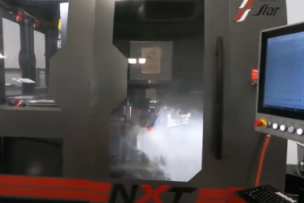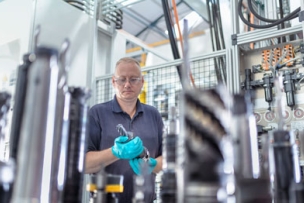What You Need to Know:
Not sure if aerospace is right for your shop? Here’s what you need to think about and plan for based on the real-world experience of a small manufacturer that invested and succeeded in aerospace.
If your shop needs more work or is looking to increase its production of parts and componentry—and make a nice profit at the same time—aerospace is a good place to be.
“Aerospace is a pretty active market segment right now—the global economy is strong and there are a lot of people traveling,” says Reid Leland, founder and CEO of LeanWerks, a precision machining and engineering shop in Ogden, Utah. “Airlines are buying new planes, which is creating big backlogs and a need for spare parts, so there’s work to be had.”
But aerospace is not a good market for shops that have processes and approaches to work that just don’t fit, he says.
“You have to be good at dealing with a high degree of paperwork and understand how to sort through flow-down requirements, government regulations, and company auditing and tracking—there’s just a lot of red tape with it,” he says. “But if you’re set up to handle all those administrative and paperwork processes, it’s a good market.”
According to Leland, many shops run the same equipment and have good machinists who are capable of making parts that meet similar dimensional requirements—whether it’s a jet engine part or a tractor part. The difference is the amount of oversight, red tape and administrative requirements.
“You’ve got to have a lot of processes in place on the shop floor, too, that are more about validation and confirmation than they are about actually making the feature,” he says. “Those are kind of built-in insurance policies that the industry requires, to make sure that you have calibration processes and certifications and all that it takes to meet the requirements of the industry.”
What Are the Requirements to Become a Successful Aerospace Operation?
Aerospace shops must have a good quality management system certified to AS9100D requirements.
The AS9100:2016 registration is the most recent version of the international management standard for the aircraft, space and defense industry, based on the ISO 9001:2015 quality standard. The AS9100 registration helps to ensure a product’s quality, conformity, safety, airworthiness and reliability. Shops that get the AS9100 audit are certified to both standards.
“The quality management people in an aerospace shop need to understand the requirements for shipping and receiving, and accounting,” says Leland. “More than for the oil and gas industry, there are some nuances, for example, such as notifications for shipping completed parts, including pre-shipping requests and approval to ship.”
Quality managers have to understand the specific aerospace requirements, Leland says, and to the extent those requirements need to be addressed by the machinists, they need to be trained on them as well. A good example is the exacting method for filling out an inspection report.
“If you’re writing it manually with pen and paper, there are certain requirements for writing down measurements and how to change them if needed,” Leland says. “So, for example, you’re not allowed to scratch something out and write a new number—you have to make a single strike-out and write your initials and the date next to the change—if you don’t, you’re not in compliance with the standard.”
What Are the Equipment Requirements for an Aerospace Manufacturing Shop?
From an equipment standpoint, the requirements will depend on which subcategory of the industry a shop will specialize in.
“For a production part that goes on an airframe, you need good CNC equipment, such as a turning center and milling center,” Leland says. “You probably need some automation, such as a flexible manufacturing system (FMS), which is typically a horizontal machining center with a material handling system for higher-volume work.”
But he says there’s a good subniche opportunity for shops that want to provide one-off parts using manual equipment.
“A lot of military platforms don’t have active supply chains for spare parts,” he says.
“Someone may need to retrofit an A-10 [plane] and there’s a gadget that goes on it that is no longer supported, or the company that originally built it is no longer in business,” Leland says. “They may send out a 40-year-old drawing package, and a lot of times it’s a project in and of itself to develop a consensus interpretation of the drawing—and sometimes the material is no longer available, so you have to get alternate materials approved.”
This type of shop might be awarded a contract to build two brake rotors, axles or pistons.
“It could be done on a CNC, but you also could do it on a good set of manual equipment with the help of high-end journeymen machinists,” he says.
In addition to aerospace parts, a company may choose to do defense and weapons systems work, which has similar requirements, making it a good crossover market.
“For a production part that goes on an airframe, you need good CNC equipment, such as a turning center and milling center. You probably need some automation, such as a flexible manufacturing system (FMS), which is typically a horizontal machining center with a material handling system for higher-volume work.”
Training Aerospace Machinists
Despite the opportunities in aerospace, manufacturing job shops can often face another hurdle: finding the right machinists for the potential work. For many seasoned machinists, it is a welcome challenge, as it allows for additional learning and to build new parts and components. But it could mean needing to hire new employees, too, and developing programs for training.
“Even though there are good training opportunities at vocational and trade schools in our area, a number of years ago we were faced with the challenge of finding skilled machinists, so we decided to take control and create our own training program that dovetailed with the local schools,” Leland says.
To accomplish this, LeanWerks hired Paul Harbath, a lean-manufacturing expert with 27 years of industry experience, to become the director of quality and continuous improvement. Harbath had a unique vision for a way to deliver aerospace training.
“He recognized that new kids coming into the workforce today are internet savvy, so we should build our training around that,” Leland says.
The result is a unique, in-house program hosted on a WordPress website, with the LearnDash plug-in, which turns the site into a learning management system. LeanWerks calls it the Technical Excellence Training (TExT) program.
The TExT administrator can upload and organize all the content, including topics, lessons and courses on the website, so employees can log on with their credentials and view the training content. The administrator controls an employee’s progression through the content so that as they complete one section, a new one opens up and the TExT program tracks their progress in real time.
To validate on-the-floor training, a mentor signs a card verifying that the employee has successfully demonstrated each skill or ability and scans the card into the TExT system.
“The program has been especially helpful for our aerospace customers because some of them only want qualified personnel to run their parts,” Leland says. “Because we can track employees as they go through the program, we have a ready-made list of everyone who is qualified to work on certain parts.”
Have you explored aerospace manufacturing as a new venture? Tell us how you entered the field in the comments below.




Talk to Us!
I want to do aeronautical engineering training
37We have a construction company in Petal MS. Mostly in sawmill, oil and gas. just trying to see if we can help with any fabrication you might need, or at least let us quote. Thanks.
46You can post messages like this in the forum if you'd like to connect with folks who need a quote. https://www.mscdirect.com/betterMRO/forum
45We are manufacturing Aircraft Internal and External Decals, also we are certified for AS9100D, ISO9001,14001 and 45001. And our materials are Meet the FAR requirements for Fire Retardant. Currently few airlines are erquesting organisation approval from their Civil Aviation Authorities, So what type of organisation approval we need from Civil Aviation Authority to supply these decals to Airlines. (FAA, EASA or other civil aviation authority corresponding to their state Type certified Aircraft.)
39Good post. Aviation, Space and Defense Products AS9100D certified Manufacturing Partner Visit https://www.violintec.com/aerospace-and-defense/
36Leave a reply
Your email address will not be published. Required fields are marked *